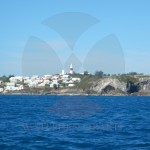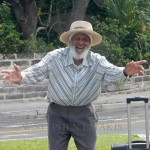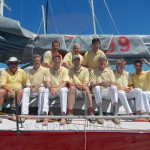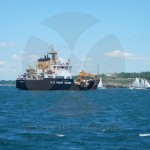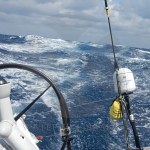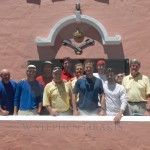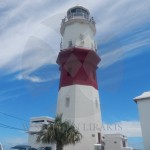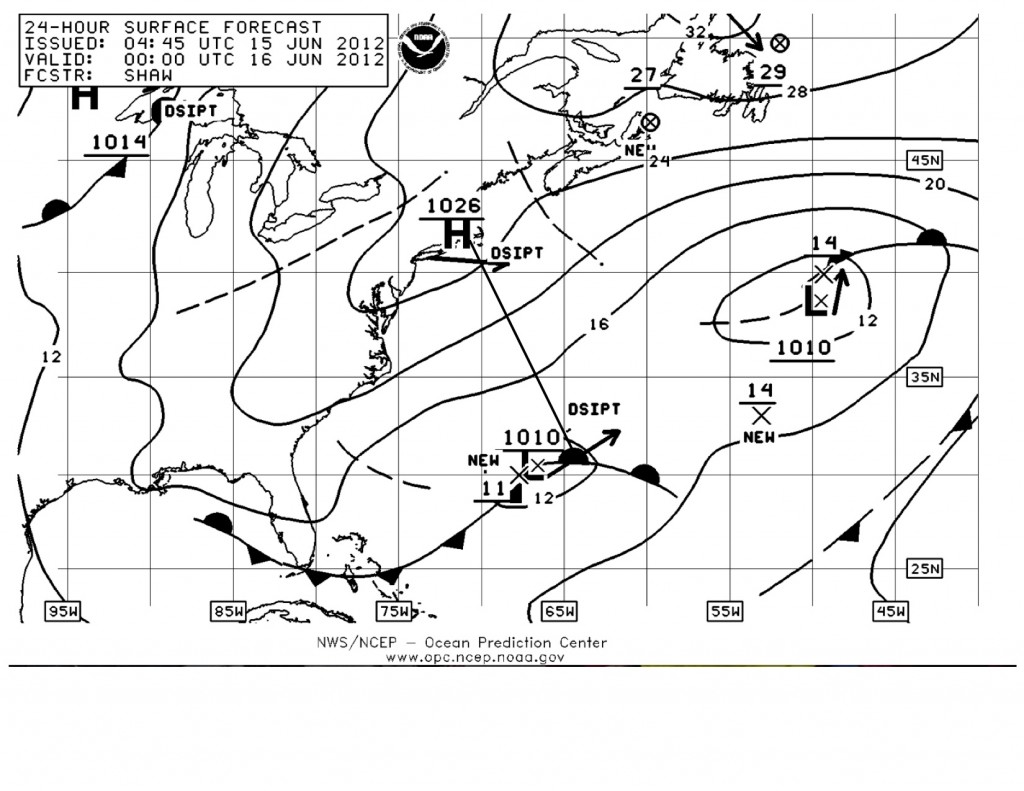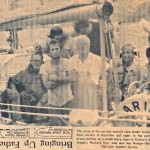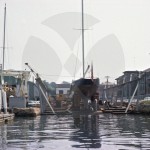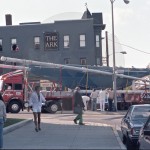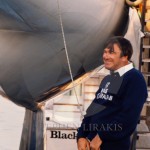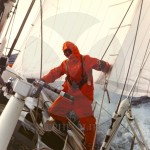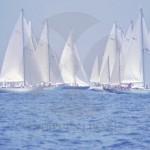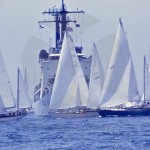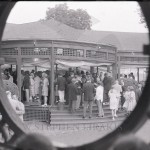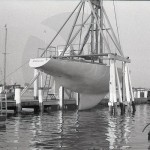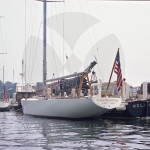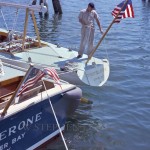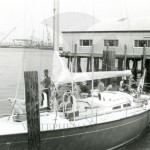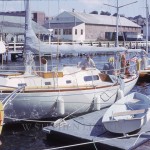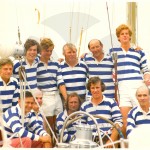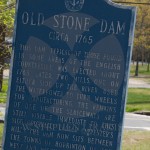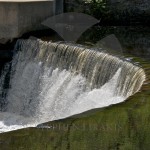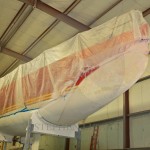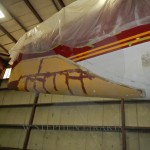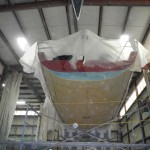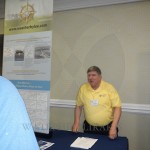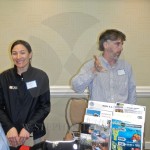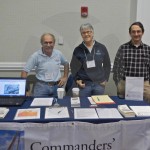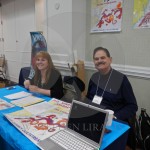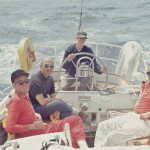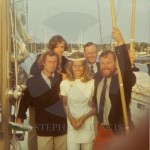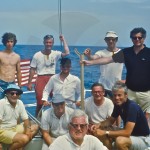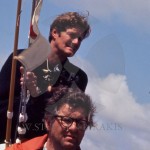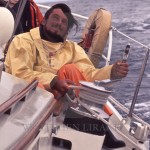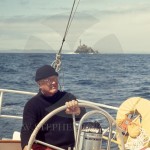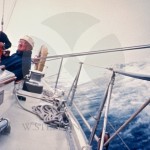“Guinevere” an Alan Gurney design for George Moffett was launched in the spring of 1966 at Jackobson’s yacht yard in Oyster Bay, NY. I sailed my first Bermuda Race aboard her and again in 1968 another Bermuda Race and the Transatlantic race to Germany; the longest race I have ever sailed (24 days); finishing in Travemunde, Germany at the bottom of the Baltic.
George was a wonderful man and a fine helmsman.
Like any long race there are so many wonderful stories; which at this point in my life I have accumulated a few.
Tag: bermuda race
ALAN GURNEY
I sailed my first Bermuda Race with Alan Gurney aboard George Moffett’s ” Guinevere”, and the 1968 transatlantic race, as well as other races. We corresponded some in the intervening years, not recently however. I am left with that feeling of one more thing I might had said or asked.
I did hear from the individual who recently purchased “Guinevere” and is in the process of restoring her. The photos he sent she looked rather sad.
EIGHT BELLS ~ ALAN P. GURNEY
By Ted Jones
Alan Gurney designed boats the old fashioned way with drafting pencil on
velum, using splines and ducks (weights), a planimeter, and a seaman’s eye.
He thought like the water through which he had sailed, in England,
transatlantic, the USA, both polar regions and much of what lay in between.
As a young lad, he would make boats out of toilet tissue (which at that
time had characteristics of waxed paper) and float them in his bath. He
spurned a career in the army to pursue a career as a yacht designer, and
ultimately moved on to an early passion, Antarctic exploration. He had
amassed an impressive collection of hundreds of photographs of every known
Antarctic penguin species.
I had the great good fortune — a privilege — to be his friend, and to
have had lunch with him frequently as he was in the process of drawing the
myriad details of what was to become “Windward Passage”, the world famous
dream boat of lumber tycoon, Robert F. Johnson. During each lunch-time
visit, I would meet Alan in his basement studio on New York’s East 54th
Street, and he would show me the most recent drawings.
Johnson had selected Gurney for the new design having been impressed by the
performance of George Moffett’s “Guinevere”, a 48 foot Jacobsen-built
aluminum yawl which had won the SORC in 1966, the second of two ocean
racers Alan had designed for Moffett. The first was a wood-built boat, the
Nantucket 38, aboard which I had the sailed in the 1964 Bermuda Race.
Later, I transferred to Humphrey Simson for whom Alan had designed a yawl
similar to “Guinevere”, the 47 foot Derecktor built “Kittiwake”, aboard
which I sailed in the 1966 SORC, Bermuda, and Transatlantic races.
“Kittiwake” did well in her class in the SORC series, overshadowed only by
Ted Turner’s legendary Cal-40, “Vamp X” which won everything in her class
that year including the Transatlantic race from Bermuda to Copenhagen.
I had met Alan Gurney in 1960 following that year’s Bermuda Race. I was a
yacht broker in the office of Tripp & Campbell in New York City when
Englishman Gurney was brought around by G. Colin Ratsey (of the English
sailmaking firm) to meet yacht designer Bill Tripp. Still only 24, Alan had
won a prestigious competition for a modern “club racer” sponsored by the
British magazine, “Yachting World” which brought him to the attention of
Chesapeake Bay yachtsman Jack Lacy for whom Alan had designed a 35 foot
sloop. While nothing came immediately of the meeting with Tripp, both
partners at Tripp & Campbell had been impressed, and when Tripp’s design
assistant resigned a short time later. The firm offered the job to Gurney
who flew back to New York to accept it. — Read on:
FAST
I am back from the Bermuda Race. I sailed on Snow Lion, a Ker 50. We completed the race in 64 hours, the fastest I have ever completed the race, a personal best, if you like. However, everyone else set new personal bests as well. The new record is 39 hours 39 minutes an 18 seconds,set by Rambler, a 90 foot RP, breaking the previous record by 14 hours.
THE FIRST 24 HOURS
BERMUDA RACE SAFETY AT SEA
The Bermuda race starts in 5 days. And we are all conscious of safety at sea. The following is copied from scuttlebutt.
STAYING OUT TROUBLE
Randy Smith is old enough. Old enough to know how to play the sailing game at a high level, and old enough to know that it is only a game. Here Randy reflects on how he stays out of trouble when heading offshore…
———————————————————————-
I have grown up sailing, cruising, racing and delivering boats up and down the California and Mexican coastlines, along with racing to Hawaii numerous times. Even on my early trips as a kid with my parents on the family Cal 29, we encountered ships on the way to Catalina Island. I was always taught by my dad to know where the shipping lanes were on the chart and what VHF Channel 16 was for.
Fast forward 40 years, experience has made me a huge proponent of safety procedures: talking about them, practicing for them, writing down notes and most importantly, asking the questions that nobody wants to hear. Having everyone on board know how to use the GPS in an MOB situation, how to start the engine, where the ditch bag is, where the flares are, how to light one off, etc. People who I have sailed with know that I have become a bit of a fanatic in this regard, sort of a safety nerd. But the good news is, it is starting to become cool to be a nerd. Just like the movie Revenge of the Nerds.
With regard to protocol on commercial traffic, it is simple. The watch captain on deck has the ultimate responsibility to keep track of the surroundings. Ships are quite easy to see in day or night, and if you don’t have people on board with the knowledge of what a ship looks like in all conditions, you probably shouldn’t be out there.
I have sailed on boats with and without AIS (Automatic Identification System). For offshore and coastal racing, my experience with AIS is the same as radar. AIS is a very nice convenience, but we usually use it to confirm what we are already seeing with our eyes.
I have had some interesting close calls, including a large aircraft carrier off San Clemente Island, oil tankers in the shipping lane between Anacapa Island and Santa Barbara, and even large unlit commercial fishing vessels in Mexico with very confusing lights. Even in last year’s Transpac Race, we encountered a very large container ship coming up from astern at a steady collision course bearing. We heated up our course by 15 degrees well in advance, and it was as if he was trying to get close to us just to see us. When they were within 1/2 mile or so, they hit us with a giant spotlight and then turned right by about 45 degrees. Our next step would have been to call on VHF 16 and ask “WTF?”
When in doubt, we immediately get on the radio and/or make a course alteration to make our intentions obvious to the ship. In the event of fog, we would immediately deploy our radar reflector if not already rigged. I really cannot imagine a scenario where you could not see a large ship coming in day or night.
As always, most races are won and most tragedies are avoided before the boat ever leaves the dock. Attention to detail and confirmation that EVERY crewmember on board has an understanding of the following items seems to be the most sure fire way to interact with commercial shipping traffic and problems:
– Keep a diligent watch at all times.
– Upon sighting a ship, confirm changes in range and bearing or if bearing is not changing and too close. Determine what action is necessary.
– If AIS equipped, confirm with navigator the data on the ship.
– Without AIS, call on VHF 16 sooner rather than later.
– If a gybe or sail change will be required to avoid, get the off-watch up early to be prepared.
– Empower EVERY crewmember on the boat to know how to use the tools you have and establish a clear line of communication.
– Most importantly, remember this is just a sailboat race. Getting too close to a ship or land to make a small gain is just not worth it.
– If you sail with new people or on a new boat, confirm the level of experience and knowledge. Ask questions… your life could depend on it.
– When joining a new team, BE A NERD. Bring a higher level of knowledge, safety and seamanship to the team. They will appreciate you.
BERMUDA RACE NEXT WEEK
Like many mornings I started out with one idea and soon moved to another. Today blame Larry Suter. He made a post on Facebook that triggered other thoughts.
Newport is about to start the summer sailing season in ernest. The New York Yacht Club spring regatta starting tomorrow, the following friday is the start of the Bermuda Race. The America’s Cup World Tour will be starting when I return from Bermuda. then Tall Ships. On and on. Many discussions have debated whether or not the expected crowds will materialize for the America’s Cup. I guess we will know soon.
Every photograph has a story, a memory, a smile, a friendship connected to it.
THE DATE SAYS SPRING
We continued our search for sites of former mills in Rhode Island last weekend. Spring was evident, it has come early for us this year, but not without a price. Although it does not show in the photographs of the dams; the water table is very low as a result of a relatively dry spring and little snow this winter.
Alterations to Snow Lion are nearing completion, we all have high hopes of a speed advantage beyond the rating increase. The Bermuda Race start is a little over six weeks away. The longest days of the year. By the time I return from Bermuda the days will be already getting shorter.
GULF STREAM
The Bermuda Race is the big sailing event, particularly on the East Coast. Yes the America’s Cup is coming to Newport after the race leaves.
The Bermuda race is traditionally broken into three parts, the race to the north wall of the Gulf Stream, the Stream, and the race from the Stream to Kitchen Shoals. Really the Gulf Stream is the obstacle on the race course. I have only sailed 12 races, (my first in 1966) but I have still managed to see many unusual events.
Click HERE to see an animated view of the stream so far this year. It is what has already happened so it will not be much help for what will occur in June, but shows just how much change can happen.
BEING IN THE RIGHT PLACE
Today is St. Patrick’s Day, a big day in Newport with a parade and everyone wearing a grin. Tucked in a corner is the CCA’s Safety At Sea Seminar; typically held every March in Newport in preparation for the Bermuda Race.
We must remember this is a 4 day race, 6oo miles. Not really a long time; it does get you offshore away from land but not for long. I don’t need to attend as I qualified last year for the the transatlantic race, 3000 miles, and 16 days.
The way to win this race is being in the right place for weather and to maximize the benefit of the Gulf Stream. It is far more important than sailing fast. The people in the following pictures can help put you in the right place.
A REUNION OF SORTS, A CARINA EVENT
It is really about Dick Nye gifting the trophies the “Carinas” had won over the years to the Indian Harbor Yacht Club, coupled with the publication of a book of the history of the “Carinas” and the family whom owned them. I was part of the crew for only a short period of time, 2 transatlantic crossings, 2 fastnet races, 2 admiral’s cups, 1 bermuda race, and of course all the smaller races during that time. I keep many fine memories and hope to see many of the former crew there.

